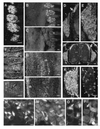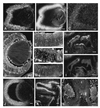Expression of galanin and a galanin receptor in several sensory systems and bone anlage of rat embryos
- PMID: 8962153
- PMCID: PMC26234
- DOI: 10.1073/pnas.93.25.14901
Expression of galanin and a galanin receptor in several sensory systems and bone anlage of rat embryos
Abstract
Using in situ hybridization and immunohistochemistry the expression of, respectively, prepro-galanin (pre-pro-GAL) mRNA and GAL receptor-1 mRNA, as well as GAL-like and GAL message-associated peptide-like immunoreactivities, were studied in rats from embryonic day 14 (E14) to postnatal day 1. GAL expression was observed already at E14 in trigeminal and dorsal root ganglion neurons and at E15 in the sensory epithelia in developing ear, eye, and nose, as well as at E19 during bone formation. Also, GAL receptor-1 mRNA was expressed in the sensory ganglia of embryos but appeared later than the ligand. These findings suggest that GAL and/or GAL message-associated peptide may have a developmental role in several sensory systems and during bone formation.
Figures




References
-
- Tatemoto K, Rökaeus Å, Jörnvall H, McDonald T J, Mutt V. FEBS Lett. 1983;164:124–128. - PubMed
-
- Rökaeus Å, Melander T, Hökfelt T, Lundberg J M, Tatemoto K, Carlquist M, Mutt V. Neurosci Lett. 1984;47:161–166. - PubMed
-
- Melander T, Hökfelt T, Rökaeus Å. J Comp Neurol. 1986;248:475–517. - PubMed
-
- Skofitsch G, Jacobowitz D M. Peptides. 1985;6:509–546. - PubMed
-
- Ch’ng J L C, Christofides N D, Anand P, Gibson S J, Allen Y S, Su H C, Tatemoto K, Morrison J F B, Polak J M, Bloom S R. Neuroscience. 1985;16:343–354. - PubMed
Publication types
MeSH terms
Substances
Grants and funding
LinkOut - more resources
Full Text Sources
Other Literature Sources

